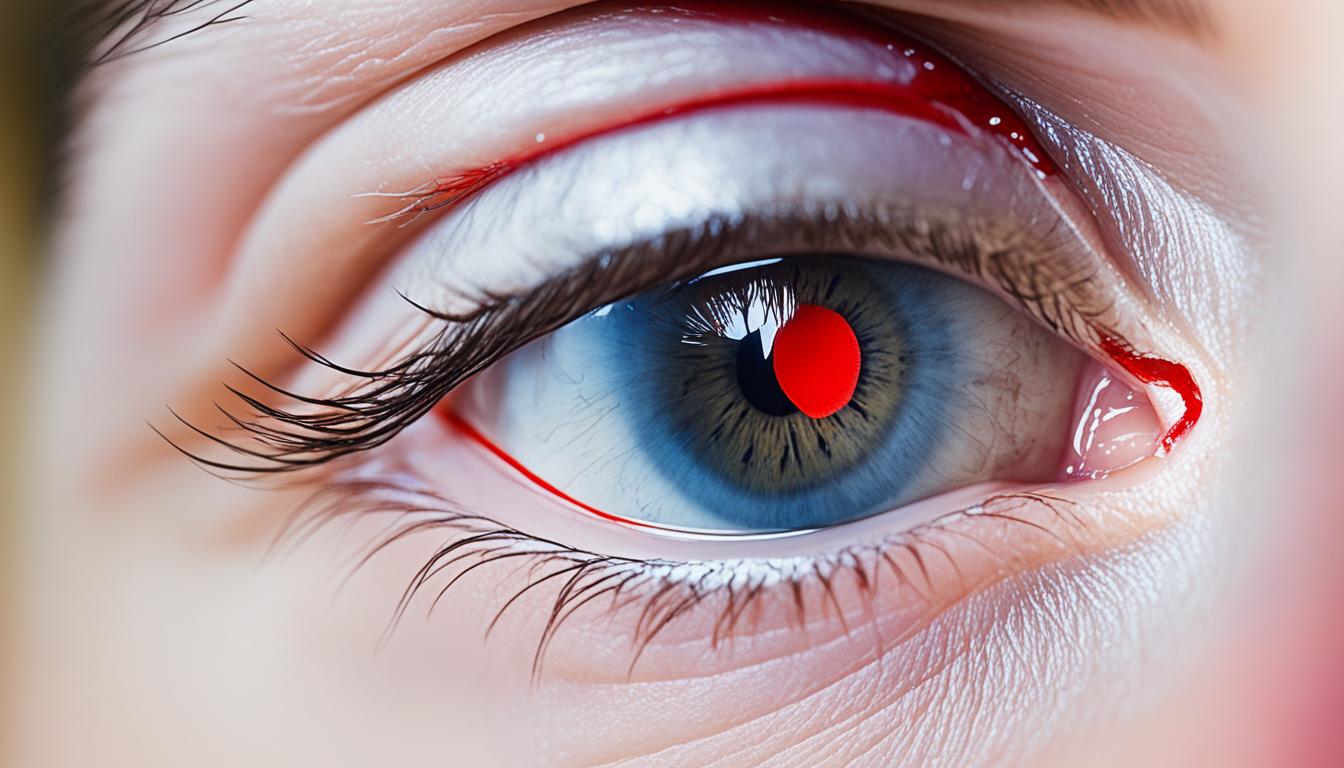Subconjunctival hemorrhage is when a small blood vessel in the eye bursts. This causes blood to leak onto the eye’s white part, or the sclera. It makes the eye look red and might worry those it happens to. However, it’s usually not serious and goes away on its own.
The cause of this condition can vary. It might happen from wearing contact lenses, eye injuries, or from intense exercise. Some medicines or health problems could also make it more likely to occur.
Key Takeaways:
- A subconjunctival hemorrhage is caused by a burst vessel in the eye. This leaks blood onto the eye’s white part.
- It’s usually not serious and will get better without any treatment.
- Things like contact lens use, eye injuries, and hard exercise might lead to this condition.
- Health issues and certain drugs can also play a part in its development.
- For more serious cases, stem cell therapy could be an option to consider.
Causes of Subconjunctival Hemorrhage
Subconjunctival hemorrhage is when blood leaks under the eye’s outer layer. It happens for various reasons. These reasons can be grouped into causes from injury and causes with no clear reason.
Traumatic Causes
Injury to the eye can be from different things. This includes:
- Eye injury by foreign objects
- Harsh rubbing or scratching
These actions can damage the eye’s blood vessels. This leads to bleeding under the eye’s surface.
Spontaneous Causes
Sometimes, bleeding under the eye happens for no clear reason. But, certain things make it more likely. These include:
- Health issues like high blood pressure or diabetes
- Not using contact lenses correctly
If someone has health problems, their eye’s blood vessels may be weaker. Also, wearing contacts wrong or for too long can hurt the eyes. This can cause blood vessels to break.
| Cause | Description |
|---|---|
| Traumatic Causes | Physical trauma or injury to the eye, foreign objects entering the eye, harsh rubbing or scratching of the eyes |
| Spontaneous Causes | Underlying health conditions such as hypertension, diabetes, or vascular disorders, use of contact lenses (improper use or extended wear) |
It’s important to know what causes this eye issue. This helps with the right care and prevention. If you have lots of bleeding or it happens often, see a doctor. They can check for health problems and help you treat it.
Diagnosis and Treatment of Subconjunctival Hemorrhage
Subconjunctival hemorrhage is a burst blood vessel in the eye. A healthcare professional can diagnose it with a physical exam. They look at the eye’s appearance and talk about symptoms and potential causes.
Treatment for this issue is often not needed. It usually goes away on its own in 1-2 weeks. But, if it keeps happening or there are other eye symptoms, more checks might be necessary.
Some treatments can relieve discomfort or dryness. Ice packs on closed eyes help with swelling. Using artificial tears can soothe dryness or irritation too.
If there is a blood vessel burst and head or face injury, see a doctor right away. This is to check for other serious injuries or complications that might need specific care.
Treatment Options for Subconjunctival Hemorrhage:
Burst blood vessel treatment focuses on symptom management and healing:
- Ice packs on closed eyes to reduce swelling and discomfort
- Use of artificial tears to alleviate any dryness or irritation
- Avoiding activities that may worsen the condition, such as heavy lifting or straining
These treatments aim to provide some relief and help comfort during the healing process. Subconjunctival hemorrhage usually goes away without heavy medical treatment.
Stem Cell Therapy for Subconjunctival Hemorrhage
Stem cell therapy is a new way to treat eye problems like subconjunctival hemorrhage. It shows a lot of promise in regenerative medicine. This therapy helps by promoting healing and new tissue growth. It gives new hope to those with a burst blood vessel in their eye.
This new treatment option is still being studied. It might be helpful for those who often get a subconjunctival hemorrhage. Stem cells can heal the eye faster. They offer a new chance for recovery.
But, we need more research to be sure about its safety and benefits. It’s wise to talk to a doctor before considering this therapy. A healthcare professional can give you the best advice. They can help decide if this treatment is right for you.

